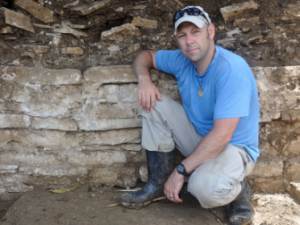The intertropical convergence zone (ITCZ), where the trade winds of the northern and southern hemispheres meet, is the world’s most important rainfall belt. New research suggests that a warming climate could lead to drier conditions in the margins of the zone, potentially exacerbating social tensions and possibly triggering mass migrations in the Neotropics, which include Central America.
Douglas J. Kennett, a professor of environmental anthropology at UC Santa Barbara and one of 10 authors of “Intertropical convergence zone variability in the Neotropics during the Common Era” in the journal Science Advances, said previous research suggested that a warming climate would lead to wetter conditions.
“The message in the new paper,” he said, “is that because of anthropogenic climate change and planetary warming, the ramifications for this part of the world are that it’s going to be getting drier, and not wetter as our previous models would have predicted.”
As Kennett noted, prior work had suggested that the ITCZ migrated south during periods of global cooling, such as the Little Ice Age, roughly from the 16th to 19th centuries. Modeling and observational data, however, indicated that the ITCZ expands and contracts in response to cooling and warming, respectively.
To determine which of those hypotheses are correct, the researchers turned to speleothems — stalagmites — in Yok Balum Cave in Belize, on the northern margins of the ITCZ. Kennett, who has been working at the cave since 2006, said its stalagmites — created over the millennia by dripping water — provide an exceptionally accurate record of rainfall for the Common Era, roughly 400 AD to the present.
Using uranium-thorium dating techniques in combination with thousands of carbon and oxygen isotopic measurements, the researchers compiled a detailed record of rainfall for the site. They found that during the warm Medieval Climate Anomaly, southern Belize was quite dry, similar to modern central Mexico. During the Little Ice Age, however, the region experienced its wettest period of the past 2,000 years.
“What we’re finding is that in fact it’s getting dryer, and that’s because ITCZ is contracting,” Kennett said. “So a warming Earth in this particular case actually means drying in Central America.”
While the paper presents a strong case for a drier climate in the Neotropics, it also sounds an alarm on the potential for aggravating social unrest among the millions of people within the region, especially those who depend upon subsistence agriculture. Central America alone is already seeing mass migrations related to political unrest.
“As an environmental anthropologist I’m interested in how people respond to changing climatic conditions,” Kennett said. “And one response could certainly be increased social unrest that exacerbates the large-scale migrations we are already seeing in Central America. So, there are things about our climate study that are important from a social science perspective. Like, what are the implications of increasing aridity for agricultural productivity, economic viability and the stability of communities in different parts of Central America, including in the Maya region where we’ve done a lot of work?
“We can see in the archaeological record for this region,” he continued, “that wetter climatic regimes correlate with societal prosperity, including robust agricultural systems and economies, and then there are times when this prosperity is undermined by drought. In some instances, we see adaptation and persistence. But in other cases, there’s societal fragmentation, warfare and migration.”
Looking ahead, Kennett said the paper should be seen as a springboard for taking action to deal with climate change.
“The next step is that we collectively come up with strategies for dealing with increases in aridity throughout Central America moving into the future,” he said. “And that basically comes down to contemporary nation-states — United States, Mexico, Belize, Guatemala, Honduras, El Salvador, Nicaragua, Panama — taking notice of this study and thinking creatively and cooperatively with the global community and actually doing something about it.”
Other authors of the paper are: Yemane Asmerom, University of New Mexico; James U.L. Baldini, University of Durham, U.K.; Keith M. Prufer, University of New Mexico; Victor J. Polyak, University of New Mexico; Harriet E. Ridley, University of Durham; Valorie V. Aquino, University of New Mexico; Lisa M. Baldini, University of Durham; Sebastian F.M. Breitenbach, Ruhr-Universität Bochum, Germany; Colin G. Macpherson, University of Durham.







